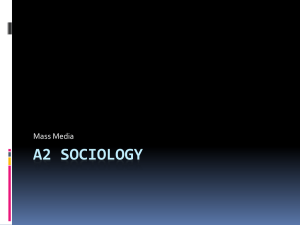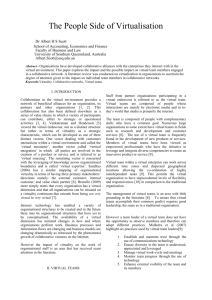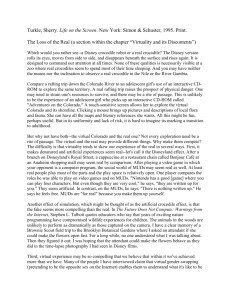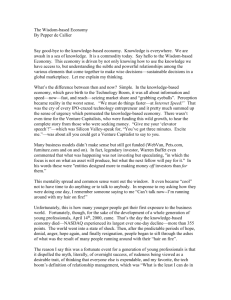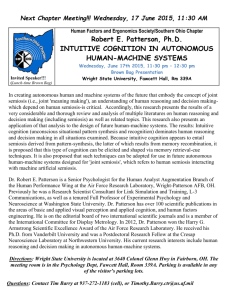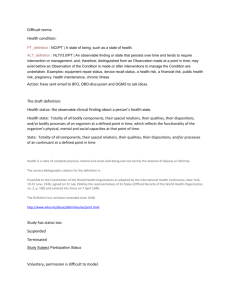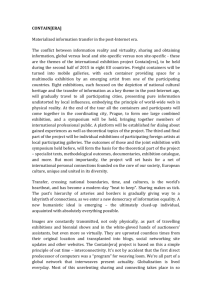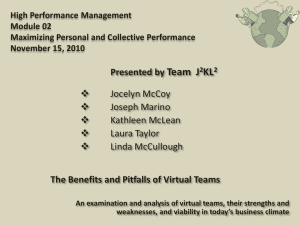WORD
advertisement
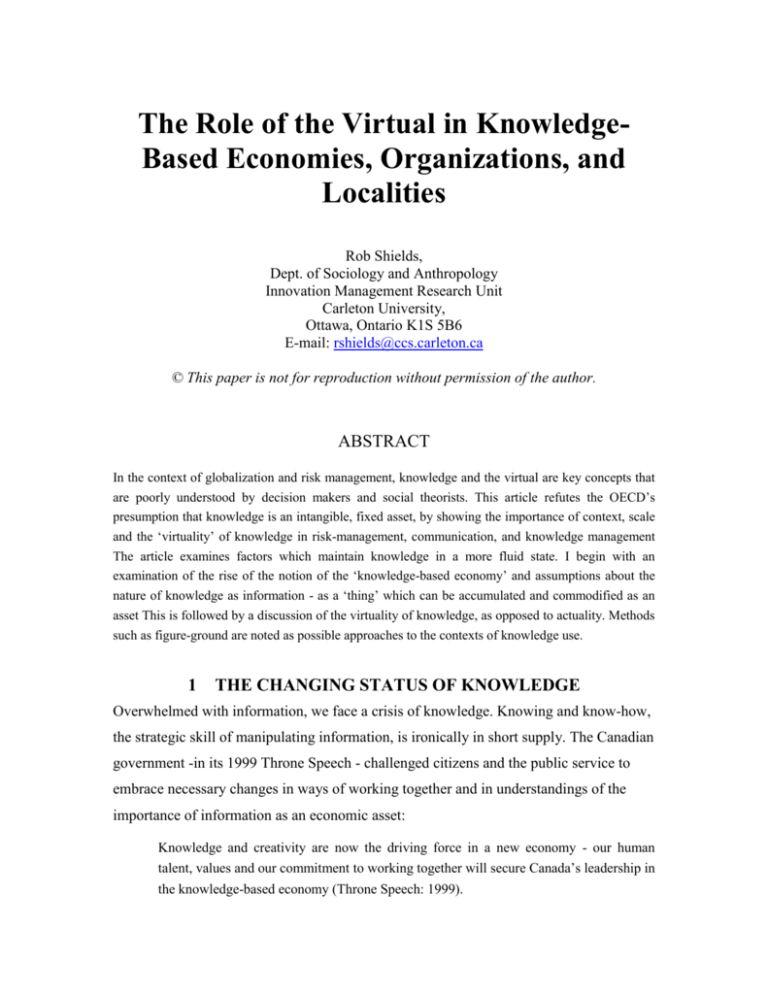
The Role of the Virtual in KnowledgeBased Economies, Organizations, and
Localities
Rob Shields,
Dept. of Sociology and Anthropology
Innovation Management Research Unit
Carleton University,
Ottawa, Ontario K1S 5B6
E-mail: rshields@ccs.carleton.ca
© This paper is not for reproduction without permission of the author.
ABSTRACT
In the context of globalization and risk management, knowledge and the virtual are key concepts that
are poorly understood by decision makers and social theorists. This article refutes the OECD’s
presumption that knowledge is an intangible, fixed asset, by showing the importance of context, scale
and the ‘virtuality’ of knowledge in risk-management, communication, and knowledge management
The article examines factors which maintain knowledge in a more fluid state. I begin with an
examination of the rise of the notion of the ‘knowledge-based economy’ and assumptions about the
nature of knowledge as information - as a ‘thing’ which can be accumulated and commodified as an
asset This is followed by a discussion of the virtuality of knowledge, as opposed to actuality. Methods
such as figure-ground are noted as possible approaches to the contexts of knowledge use.
1
THE CHANGING STATUS OF KNOWLEDGE
Overwhelmed with information, we face a crisis of knowledge. Knowing and know-how,
the strategic skill of manipulating information, is ironically in short supply. The Canadian
government -in its 1999 Throne Speech - challenged citizens and the public service to
embrace necessary changes in ways of working together and in understandings of the
importance of information as an economic asset:
Knowledge and creativity are now the driving force in a new economy - our human
talent, values and our commitment to working together will secure Canada’s leadership in
the knowledge-based economy (Throne Speech: 1999).
Yet, in Euro-American societies, cultural understandings of the nature of knowledge
as ‘information’ are strongly resistant to fluid and processual theories of knowledge.
Instead, the current commodification of knowledge as ‘information’ rests on an
assumption that knowledge is, as the Organization for Economic Cooperation and
Development (OECD) expressed it, an intangible asset of organizations. This
understanding contributes to the logic behind the privatization of parts of public sector
organizations, which are indeed rich in both know-how and information concerning
populations, intellectual properties and markets. For those governments that have bought
into the propositions of the knowledge-based economy the tendency is to commodify
information and outsource capacities for drawing knowledge out of information, but as
our research shows, this slows down the circulation of information and poses particular
feedback problems for public agencies - often leading to policy failures.
This article refutes the OECD’s presumption that knowledge is an intangible, fixed
asset, by showing the importance of context, scale and the ‘virtuality’ of knowledge in
risk-management, communication, and knowledge management. Knowledge exists only
in the contexts of particular locales and in relation to defined purposes. These might
include projects in specific places, as well as knowledge relevant to larger scales, such as
the operation of a national or international organization or project. Knowledge is an
analytic operation flowing from the synthesis of information. This includes translating
general and global-scaled information into relevant knowledge by combining and
selecting information in relation to the needs in specific locales. Out-of-context or
separated from projects, knowledge is dead information; it is trivia.
A discussion of knowledge and the relationships between the material, the abstract,
the probable and the virtual is also necessary, in order to clarify several further points:
The ways in which knowledge operates on information.
The manner in which ideal-real virtualities stand-in for actual experience or
perception of distant contexts and imagined totalities such as the global, with its
‘presence of absence.’
The changing nature of knowledge and how this figures in notions such as the ‘risk
society.’
With regard to (a) and (b); knowledge is not only abstract but virtual, while
information is actual and even material. The virtual allows us to ‘connect-the-dots’ of
actual sense data to inform ourselves and society about relationships between events,
ideas, and contexts. It allows us to recognize the relevance of the past. This suggests not
only a spatial shift in the homecoming of the virtual (distant abstract absences come to be
understood as virtual presences) but a temporal change in the historicity of modernist
reason, that is to say, the past takes on new significance as an active presence. As I shall
argue, methods change: the example of figure and ground illustrates there are existing
conceptual resources available to us in ‘operationalizing’ the virtual in a theoretically
rigorous manner. With regard to (c), recognition of the importance of virtual as a
category implies a change in the nature of knowledge and change in perception within
Western professional culture and its notions of reason
2
COMMODIFICATION OF KNOWLEDGE
The assumptions guiding this notion of the commodification of knowledge—together
with enormous investment in research and infrastructure surrounding this topic—are that
the economies of the OECD countries are facing a transformation comparable to that of
the industrial revolution. Knowledge becomes a form of capital. These intangible assets
supplement tools, money and land. This recognition leads to changes in organizations and
societies, including the boundary between public and private spheres, and local and
global scales. The discovery of these ‘new’ assets has involved changes in the accounting
profession, in the way in which companies and individuals are valued and has contributed
to the erosion of public organizations, who suddenly appear to occupy a niche of new
‘knowledge-based economy’ which is rightfully the domain of laissez-faire capitalism. In
the shifting boundary between public and private, then, the commodification of intangible
assets is a key link between cultural theory, fashionable neo-conservative ideology, and
the conditions and practices of profitability. Observed trends are fueled by a synchronous
formation of these factors. Our research shows that managers’ and regulators’
understandings of knowledge tend to conflate it with information (Shields, Taborsky,
Jones, and O'Hara, 2000; Taborsky, 2001). As a result, organizations seeking to capitalize
on the collective knowledge of the firm and of its employees are deflected into the
acquisition of new information technologies (IT) — information-management, not
knowledge management (KM).
Knowledge is an open process of translating information between contexts and
remaking it; information on the other hand is a closed and static form. Information is not
just data, but data in sets or relations. However it is reified and frozen: it is data ‘in
formation’. This is what makes it amenable to storage and to transmission between
offices and individuals: it holds its shape. It has to be reintegrated to make sense in new
contexts, for example, at a later date; as an application of theory or lessons learned from
previous experience; in a new locale (cf. Dickens); at a different scale (Shields and
Taborsky, 2001).1
In our research, an axiom of the modern bureaucracy emerges: code all forms of
knowledge and information into one form of record (one documentary system) in order to
allow predictable comparisons and adjudications of information and to fix data and sets
as it moves between offices. The attempt at fixing, reifying, knowledge is easily observed
(Shields, Ilcan, O'Connor, and Taborsky, 2001) and a corollary is the exclusion of
humans. These become generic and mis-named ‘knowledge workers’ who are not
understood as the origin of value or the creators of knowledge, but rather those who
service and support the information and communication technologies that archive and
transmit information. Meaning is not so easily fixed. It is contextual and hence
misinterpretations are always a risk, even with the addition of redundant information
giving clues about the original context of data and how it is to be deployed in the process
of learning, understanding and drawing well-founded conclusions. We refer to this
procedure as a ‘knowledge process.’
The propositions of the knowledge-based economy (KBE) involve simplified notions
of knowledge as information. Although this builds on the modernist bias against
embodied skill, tacit knowledge and experience in favour of abstracted supervisory
knowledge, it also adds a new degree of formalization.2 Knowledge that cannot be
captured in the databases of Information Technology (IT) systems and information
management or knowledge management software is screened out - often being explicitly
referred to in the literature as ‘tacit’, begging the question of how these forms and
knowledge processes are maintained. In addition, the knowledge-based economy favours
a new ‘regime of value’ in which labour theories of value are relegated to specific ‘old’
sectors. Value is understood to lie in stocks of intangible assets and is extracted through
the management of flows - very much a return to a model of the economics of staples.
1
In Peircean terms as developed by Edwina Taborsky, we have contrasted data, information and
knowledge, defining information as contextual and in ordered relations (Peircean secondness). It is
transmissible but must be re-orderd or placed in new relations with elements of the new situation or locality
to which it has been transmitted or applied. This interactive reorganization, mediation or new synthesis is
knowledge-as-process (Peircean thirdness (Peirce, 1931-66 Vol 1.345; Vol 8.331); Bakhtinian dialogism
({Bakhtin, 1981).
2
Standardized forms insert actual practice into a limited range of static Aristotelian categories.
They operate not only a translation media but as selection tools. Nespor (2000:6) notes that they are the
least adaptable and most reductive boundary objects, but, given their usual form as numbers, also the
easiest to move and combine, and the most stable as they move between contexts. Latour points out that
such forms make it possible to organize large-scale networks with asymmetrical flows and thus to create
centralized systems of power by fixing representations in a manner which can be communicated,
aggregated and compared efficiently and effectively (Latour, 1999: 223).
Such an understanding of ‘value’ is a surprising simplification of the complexities of
service sector economics and the economics of intellectual property for the purposes of
control.
In the key sectors of the knowledge-based economy humans are involved in the
managed organizational form of ‘the team’. Innovation is not accounted for on the basis
of individuals (talent, expertise), but as an outcome of collective problem solving. This
generates a collaborative office environment with specific internal and regional
geographies of work including relationships or morphologies, proximities, and scales
(Shields, 2001).
We work in everyday life in many countries in so-called ‘virtual teams,’ that is
through email and phone or videoconferencing, groups are assembled to address
particular types of problem, to respond to crises, or to pursue very specific projects—
springing into action with the lightness of electrons but winding up their operations at the
conclusion of a project. If these teams are fleeting, they can be recalled back into
existence, like a computer file redisplayed on a video screen (see Lipnack, 1997; Hughes,
1998). They are ‘virtual’ if only because they are neither face-to-face nor propinquitous
(local); rather they are far-flung, intangible, and latent. When we attempt to imagine
them as actual, we end up with a paradox of partially-present objects which disappear
into their networks and media.
Their supporting infrastructure is a rented communications link, thus they leave few
tangible traces other than email records and archived recordings of videoconferencing.
All such virtual objects, sets and environments have an existence which is less typical of
the phenomenological present-at-hand and more typical of the non-existent and nonpresent. An appropriate analogy would be that of mathematical sets which exist only by
virtue of their members (see below). When we speak of the global and other imagined
totalities in relation to the local, we are posing a form of the relation between the ideallyreal and actually-real. Many people easily imagine and subscribe to campaigns to aid
distant others. They talk without hesitation to absent interlocutors on telephones. We
accept televisual reporting as ‘live’ from a location we know only abstractly.
The management literature advocates strongly in favour of a transition to a
knowledge-based economy, with a very few papers highlighting the impact on workers’
private lives, and the governance of the workplace (increasing credentialism, redefinition
of jobs etc.). Less attention is posed by the risks such changes entail and the relationship
between knowledge economy and the management of risk or uncertainty. Even in
countries which have traditionally had a public system of education, private firms have
increasing influence on the education and training of citizen;. through distance learning,
coaching, information and on-line courses on the web. At the same time, governments are
heavily investing in wiring public schools as fast as possible. An important question is
whether the increasing use of non-governmental knowledge services in the education
sector opens that sector to the risk of private interests prevailing over the public interest
in that sector. The same question can certainly be asked for many intangible capitalintensive sectors such as the health and the scientific sectors (OECD, 2001:2).
Private enterprise is brought into direct conflict with the public sector as intangible
assets - accumulations of information and this broad simplified notion of knowledge - are
commodified. Public services such as those offered by health care institutions have come
to depend on a supporting infrastructure of private firms which provide specific
diagnostic information (lab tests furnish knowledge and records of blood conditions,
ultrasound scans and interpretations furnish anatomical knowledge and so on). In Canada,
the result is a veneer of services provided directly by the government - but all rest on a
public-private ‘knowledge economy’ reflected not only in ‘contracting-out’ but the
everyday networks and interactions of public servants and the private providers of
traditionally-public services. In effect, the economic division of public and private
services becomes an increasingly academic distraction from the hybrid service delivery
systems that have been put in place.
3
KNOWLEDGE PROCESSES AND COMMODIFICATION
Commodification restricts the circulation of information proper and contributes to its
senescence. Our research suggests that this risk may be offset only temporarily by
increases in the data-gathering power of computer systems. As knowledge is
commodified as a service provided by just-in-time expert consultants, the problem of the
timeliness and relevance of information increases - ‘garbage in, garbage out’. States
contract out the interface with ‘clients’ and citizens - a key learning opportunity. The new
private and even quasi-state delivery agencies appropriate feedback and information, and
this must be purchased back again by the State. Its original context and conditions of
relevance are difficult to verify, requiring further surveys be commissioned. New types of
risk emerge, including information bottlenecks and ‘knowledge gaps’, which appear as
time lags in the decision-making of State organizations. Information relevance problems
appear as organizations lose ground in a race to keep up with developments. These
appear in the spectacle of debates over trivia - for example, the European Union’s
preoccupation with the density difference between canned vegetables (mushy peas) and
vegetable sauces (National Post Jan 9, 2000), or the Canadian government’s new
machine for differentiating between crackers and cakes by testing their ‘snap’ (Space and
Culture, 2000). New forms of populism may well serve to mitigate politically such
knowledge shortfalls.
The context of the consolidation of a knowledge-based economy is increased
globalization and with it, the opening of national economies and cultures to increased
levels of change, risk and unanticipated impacts. Culture change-problems emerge in the
face of this dynamic. Political, cultural-economic and even climatic environment are high
on our list of possible indicators of the generally slowing flow of knowledge in society:
for decision-making within a speeded-up telecommunications environment is
concomitant with the decay of ‘frozen’, unrefreshed or untimely information. The latter
can be considered as an entropic condition which eventually leads to ‘knowledge iceages’, a thermodynamic collapse of cultural-economic systems. One indicator is that of
the popular outrunning the official, authoritative knowledge networks. Beck has argued
that popular circuits of information and lay processes of knowledge-formation (everyday
experience, urban myths, health fads and so on)3 produces a new politics, a political
revolution stemming from unintended side-effects of industrialization (Beck, 1992:61-2).
To the extent that the accepted bases of certainty are eroded, ‘space is opened up for
alternative forms of knowledge’ (Beck, 2002:18) which become prominent in public
justifications for opposition and non-compliance. But although the popular may drive
culture, it cannot steer the socioeconomic system in a rational manner - witness
Argentina’s populist management of the government over the 1990s, which exhibited
extravagant spending naively fueled by International Monetary Fund (IMF) loans.
In everyday contexts - spaces of action - respondents own understanding of risk must
be produced in relation to local factors, whether these be a local industry or local
acidification of the environment, personal behaviours and interactions - even sexual
choices in the context of HIV/AIDS. The essence of a knowledge-process is the taking-up
of various sources of information and re-forming and synthesizing with respect to a
pragmatic orientation and context. However, risk calculations are rendered more difficult
3
It is no wonder we witness an increasing primacy of the body as both a recording mechanism and
medium by which impacts are observed and measured. Risk is discussed in public institutions in the expert
terms of science, but experienced as immediate, personal illness and misery (see Tulloch and Lupton,
2001:14). Conventionally-private and public forms of knowledge and experience become inextricably
entangled.
because of the difficulty of obtaining sufficient information on which to make causal
interpretations of everything from toxins to economic potential. For example problems
representing risk and complex systems in scientific terms are compounded by the
everyday invisibility of environmental hazards. In the case of economic risks, social
science delivers equivocal answers, while it is difficult to link policy with societal
outcomes in a cause and effect manner. Evaluative information, such as audits, is clouded
by consulting relationships on the side between the auditors and their clients, as firms
also buy-back information assets and knowledge process capacity. As for the public
sector, there are few mechanisms by which public agencies learn from the impacts of
their policies because of the lack of evaluation and responsibility. Here both staff and
politicians turn -over after a few months or years, leaving others to deal with problems
arising from policies and programs (OECD 2001:5).
4
THE VIRTUAL AND THE MATERIAL
Risk is a problem of knowledge and it also brings into focus the relationship between the
possible and the real - specifically the probable, the virtual, and the material. I organize
these in Table below as a tetrology:
Real (existing)
Possible (non-existing)
Ideal :
virtual
abstract
Actual :
material
probable
Tetrology of the real and possible.
The virtual includes those temporal elements, such as memories, and the past in general,
which are not simply abstractions without grounding, but are real ideations (day dreams,
the past and so on). In idiomatic English, one might also describe a future task as
‘virtually complete’, trying to convince one’s interlocutor that it is ‘really’ but not
actually finished. The virtual is thus ideal but also real.4 The preference for materialism
emphasizes the actual-real, which is context-bound, but the virtual is a required category
4
This is the subject of a forthcoming book, The Virtual (Routledge 2002). Here there is only time
and space to sketch the argument.
for distinguishing non-existing and ideal abstractions, concepts from ideal but really
existing virtualities such as memories (Antze and Lambek, 1996) and, of increasing
importance, simulations and totalities such as groups and classes. These exist in and of
themselves, but are not actualities, nor are they material.
A recognition of the virtual has been poorly developed in modern capitalist societies.
Yet it is essential to understanding the increasing need to count absences in. Previously
the absent, as a category, has been conceived abstractly, as a non-existing idealization,
giving rise to a philosophical problem of how to speak about absence except as nonpresence. ‘Out of sight, out of mind’ is a maxim that speaks to the actual and which
continues to rule the parochial context indicating non-presence. The virtual, however, is
the true category by which absent, distant decisions that impact on local routines can be
understood as real, although not materialized in a given, parochial context. The presence
of absence is virtual.5
We live in a world characterized not only by abstraction but one populated by virtuals
- the signature problem of post-modern/second modern/risk societies. ‘The Virtual’
unsettles the local, present-to-hand with a category of non-abstract invisibles or absences.
Computer-generated visualizations show a reality which may be impossible to experience
directly in everyday life or which are not representable in the traditional conventions of
paper media, such as 2D and 3D graphs or axonometrics and linear perspectives. It
troubles the nominalist and positivist sense of a bounded reality as lived, face-to-face
experience, by ushering virtuals into a whole series of realist objects which are
conventionally held to exist or are detected via probabilistic inference and mathematical
modeling. ‘Virtuals’ might be old, distant; might be something invisible but nonetheless
significant in their effects, or might be references to informal arrangements or latent
factors. The past is brought close-up into the present when we admit the reality rather
than the ideality of the virtual. Perhaps the ‘presentism’ of popular culture will be
overtaken by the weight of the past?
The virtual may have been repressed in what we might call a ‘modernist’ culture of
knowledge but can be easily observed in other cultures and in our own history. If the
virtual now returns with a vengeance, it is nonetheless a restoration in a historically new
5
I have written at length on the spatialization of absence as one shift in cultural practices and
understandings of spatiality at the end of the twentieth century. The arrival of a new solution to the problem
of ousia and parousia indicates the transcendence of an episteme regime dating even from Aristotle and
Aquinas. Please consult ‘A Truant proximity: presence and absence in the space of modernity’
Environment and Planning D: Society and Space
configuration alongside the probable (relating to risk) and the material (relating in
particular to operational decision-making). Extravagant as the claim may be, our research
on the public sector and the knowledge based economy points to a change in the nature of
knowledge which comes about because its virtuality is recognized. The virtual is readmitted into the legion of the ‘true’, present and the real, from which it has been long
denied as mere ‘belief’ (ie as ‘abstractions without grounding’) and as a category of nonexistence or absence.
5
THE ‘VIRTUALITY’ OF COMMUNICATION
Of further interest is the relations between these categories e.g. the social forms they
take, the manner in which they are integrated together in epistemic ‘world views’ and the
way they become institutionalized. All communication and representation, not just
telephony or email, involves various degrees of ‘virtuality’, depending on its form.
Deliberately forgetting the materiality of communication and the importance of
abstraction, Dimitrov and Woog refer to this process as ‘virtual semiosis’ - the potential
character of emergent meaning as a result of the interaction of experience,
communicative action and contexts.
Semiosis is inherently virtual _ it inevitably includes appearance (emergence, discovery,
creation) of connections (relations) between signs (things, events, phenomena,
processes), a priori seen as not interacting with each other. Because of its virtuality,
semiosis provides a basis for exploring holistic nature of complex reality, where
'everything relates to everything', and for eliciting distinguishable dynamic patterns
emerging out of the tangled web of interdependent relationships (Dimitrov and Woog,
1999).
Pierce argued: ‘No present actual thought has any meaning, any intellectual value; for
this lies not in what is actually thought, but in what this thought may be connected with in
representation by subsequent thoughts; so that the meaning of a thought is altogether
something virtual’ (Peirce, 1931-66: Ms.291; Paras 5.5; 7.103). According to Kauffman,
this virtual aspect of semiosis:
is not logic, nor is it the actual subject matter of the mathematics, physics or cybernetics
in which it may appear to be embedded... It is the pivot that allows us to move from one
world of ideas to another... There are many ways in which we encounter this sort of
virtuality. One way is to proceed from within an apparently logical system and push its
boundaries, find its limits. Another is to arrive from without in a leap, a bound, a jump
into something new (Kauffman, 1997:65 italics added).
To cite Dimitrov and Moog once again: ‘Emergent outcomes, as well as the means
and ways leading towards this emergence are not predetermined or certain. They are
constructed, facilitated or discovered’ (Dimitrov and Woog, 1999).
‘Virtuality,’ the pivot of emergence, is an ethical moment in communicative action.
What is emergent is knowledge as a system-coherent attractor in a complex and unstable
communication system in which chaos is always impending. However, virtuality does not
disappear but is retained in the indecipherable aspects of author’s intentions (Henry,
2001). Barnard and earlier Schutz, emphasize the empathic ability to appreciate multiple
or regional realities and values (Barnard, 1998; Schutz, 1972). The virtuality of
verstehende as ‘understanding’ has not been recognized in social science - and this is a
pity.6
6
CONTEXT AND SCALE
Context and scale is integral to the distinction between information and knowledge. The
relationships between, and play of locally-developed information and knowledge,
compared with imported, decontextualized information, is a largely unexplored aspect of
globalization and localization. ‘Global’ knowledge has long been taken up and integrated
as information to inform even the most parochial and locality-bound aspects of everyday
life. However, in these discussions, and in the more nuanced visions of ‘globalization’,
categories such as local and global have been used as resources for explanation rather
than objects of explication.
In material terms, all one can actually do is take a dialogical position of outsider to an Other’s
understanding or point view. The Geistwissenschaften doxa of sympathetic understanding propounded by
Ricket and Dilthey and subsequently developed by Weber as a key epistemological principle of qualitative
social science relies on a methodical mis-recognition of the ideal as actual, hence treating the virtual and
imaginatively othered-self as materially self-same. This willful erasure of the line between the material and
virtual is culturally essential to Euro-American notions of fiction, imagination and empathy, all of which
presume the actuality of the virtual. To empathise requires an understanding beyond the scope of the
analytic - it requires a talent for verstehen - for making the virtual stand in for the actually real - in a world
in which people more generally insist on the unknowability of the other - a radical Bakhtinian outsidedness
which must be recognized as an ethical barrier, but whose dialogical resolution lies in the very act of
recognition {Levinas, 1981). Taking the virtual as actual allows one to physically respond to perceived
states in other’s such as, for example, acting on another person’s distress. It also has importance for
demogogues - but all this is another paper
6
Scale is performative. Furthermore, ‘articulations of scale are not neutral but instead
generate inequalities and “power geometries”’ (Massey, 1999). The local, as context,
varies depending on the pragmatic orientation of the moment. To define a context is to
adjudicate a pertinence which can be eitherspatial or temporal. Context is conventionally
defined as ‘the whole situation background, or environment relevant to some happening’
(Grossman and Stodolsky, 1995:5). Context is sometimes treated as a system of
containers much like Russian dolls, expanding outward (McLaughlin and Talbert, 1993),
or as loosely coupled ‘spheres’, cycles or stages (cited in Nespor, 2001:1). Bourdieu’s
notion of ‘field’ accomplishes the same effect (Bourdieu, 1984).. Appadurai notes that
locality is neither limited to a particular scale nor a particular location in space. It is
relational and contextual.
The identity of the local as a constructed context is not the additive sum of its
elements and their linkages - it is virtual. While contexts are accretions of disparate
elements, on the basis of contiguity, context risks being made to ‘speak’ with a single
voice - since it is a form of ‘punctualized’ network of meanings (Callon, 1997) - and can
be manipulated by a single spokesperson or representative institution. Internal
heterogeneity and differences tend toward being discursively masked. Connection is
more strongly accented than differentiation. This notion of context and the local is an
example of:
parsing of the world into categories and identities which can be enrolled into
configurations, alliances, or patterns of association - defining oneself requires defining
‘others’ with or against whom one is aligned or opposed - and simultaneously blocking or
subverting alternative category systems or identity positions (by setting up appropriate
barriers, which can take the form of material organizations of space and time that restrict
contact with outsiders eg. building walls, discursive practices (the imposition of
incommensurable ways of categorizing or classifying the world), and barriers constituted
through differences of taste, style, and language, and so on). These configurations are
animated by the movement of entitities across time and space as they’re summed up,
combined, and congealed into hybrid actor-networks (Callon, 1986; Callon, 1987 cited in
Nespor 2001:6).
The ineffable quality of virtual identity reminds one of Deleuze and Guattari’s
question, ‘What is the individuality of a day, a season, an event? ... a degree, an intensity,
is an individual, a heccéité that enters into composition with other degrees, other
intensities, to form another individual. ...these....imply a flutter, a vibration in the form
itself that is not reducible to the properties of a subject.’ In short, ‘You are longitude and
latitude, a set of speeds and slownesses between formed particles, a set of nonsubjectified
affects. You have the individuality of a day, a season, a year, a life...’ (Callon, 1987:253,
262).
The cut points of a scalar geography are naturalized and not seen as contested social
outcomes. Reifying knowledge as information has very different scalar outcomes. It is a
core control mechanism in spatially distanciated processes. While it allows information to
be moved between centres and peripheries, the same processes impede active learning in
the dependent periphery. Unless information is continuously updated and reintegrated
with its context in a ‘knowledge-information dialectic’ it becomes irrelevant and we can
speak of the senescence or knowledge death of societies - a process observed in the
authoritative knowledge systems of the East European totalitarian states of the twentieth
century and in the historical past found in the feudal system, which limited authoritative
knowledge to the court and monasteries, thus leaving societies eventually unable to deal
with changes in their sociobiological environment.
Thinking about both the local and about context in the form of networks raises
awareness of how boundaries are constructed and their permeability. Network theories
purposively emphasize the interconnections between elements, disturbing the
conventional order of objects and their geographies, showing that they, ‘aren’t discrete,’
or clearly separated from their context. They do not have well-established boundaries.
They aren’t as the jargon puts it, distinct subjects and objects. Instead they are sets of
relations. And these relations are co-extensive with those networks’ (Callon, 1997:170).
The question of the rules of movement and translation remains. The knowledge network
of information, mediators and knowledge processes do not simply devolve into one single
register of phase changes between knowledge and information. These, instead take place
on multiple registers, which entail not only location and scalar shifts but translations
between actual and ideal instanciations of knowledge and information. For example,
Even a setting as immediate as a classroom encounter always has multiple linkages
stretching beyond the classroom, over the horizon, making it global as well as local in
multiple ways ... “Social and political and economic networks” cut across “ the
boundaries between spatial ‘insides and ‘outsides’ ... the local and the global are...
mutually constitutive in particular places at particular times (Smith and Fletcher, 2000:
60). Articulations with the movements of extra-local networks are constitutive of ‘local’
identities...identities and meanings are fundamentally relations, inseparable from
‘context’ (Nespor, 2001:11).
7
TOTALITY
Virtuality is also central to the imagination of totality, the intuition of the whole
expressed from observing its parts. Indexicals such as, 'here', ‘there’ and 'now' often
indicate a referent that is tangibly present - ‘Rock’, or a person’s name, and so on.
However, they also may designate a reality that appears and disappears with the utterance
- ‘America’, ‘modernity’ and so on (Mason, 1990:16). These names designate totalities:
complex spatial objects, that may amount to ‘imaginary worlds’. They are often called
‘abstract totalities’ but their existence is virtual. They cannot be found as totalities, only
in pieces or in traces that are social constructed as indicators of the existence of the
totality. As such they are concrete abstractions (Lefebvre, 1991; Shields, 1999:159-160).
They are both a product of human imagination and labour, and also a medium of social
actions, because they structure the limits for subsequent activities. But they depend on an
indexical leap from a fragment that is encountered and an abstract, absent totality, that is
conjured. ‘Wholeness is a virtual entity... The process of making meaning about
wholeness, that is, the process of semiosis, is impregnated by this virtuality’ (Dimitrov
and Woog, 2000)
For example, we can conceptualize and discuss the Internet as an ‘imaginary world’
Such imaginary worlds - such the early explorers understanding of the Americas as ‘The
New World’ cannot be seen, but they must be named - as in the case of concrete
abstractions discussed above. A name, in turn, is a part of a network, or rather of different
networks, of names. No single name can cover this imaginary world in its entirety: it is
always more than the sum of its parts. Hence the inherent excess of meaning in a term
like ‘America’ which designates indexically, but cannot be reduced to a single
description. As Wittgenstein wrote:
It seems - at least so far as I can see at present - that the matter is not settled by getting rid
of names by means of definitions: complex spatial objects, for example, seem to me in
some sense to be essentially things - I as it were see them as things. - And the designation
of them by means of names seems to be more than a mere trick of language
(Wittgenstein, 1989:47 cited in Mason 1990: 16-17).
The iconography of any object which is composed of parts, or which must be imaged
as a totality on the basis of an encounter with only a small part of it, for example a
continent, a city, even a ‘people,’ depends on the virtual. Drawing on Mason’s discussion
of the invention of ‘America’ by the first European explorers, we can say that an
ensemble of names interlocks indexically and tropologically to contribute a 'reality effect'
to such imagined totalities. It is in this sense that we can say that systems consisting of
names of 'objects' and of names of relations between objects designate entities and
relations between these entities - what they designate we call a world (Lyotard, 1984: 67;
Mason 1990). Digital domains such as the Web have opened up online environments
which do not coincide exactly with our notions of a ‘world’ as material. While a chimera
or mirage could be expected to disappear, confirming its abstract status, virtual worlds do
breach the limited totality of the known world - a geographic totality that has been closed
since the voyages of Columbus in 1492 (Todorov, 1984: 13-14).
What of ‘the global’? We are witnesses to the construction of a cross-cultural horizon
of meaning, a totality which is virtual and in which all localities can be understood to be
embedded. This totality is explored not by discovery - it has been not only almost entirely
mapped but seen and photographed by the mid-1960s (Franklin, Lury, and Stacey, 2000)
- but by the very different contexts of tourism, entertainment media and information and
telecommunications technologies.
8
FIGURE AND GROUND
Unlike the conceptual quality of abstractions, the virtual invites empathetic and embodied
commitment in the understanding immanent, invisible powers, opening the door to new
metaphors by which we might understand the current conjuncture. One finds this in the
humanities and ‘fine arts’ conception of the relation between figure and ground, which
realizes, by making visible, the relation between the not-immediately knowable abstract
(‘ground’) and the local, contextual, actually witnessed and known (‘figure’). The
compositional language by which the figure-ground relationship is understood has been
left largely in the province of aesthetics and literature. Yet it would appear that
realization of the relation between absent and present draws on the virtual as a key
moment in the conceit.
The continuities and cut-points between ‘figures’ and their ‘grounds’ can shed light
on the relationship between the local and the global and the constructed boundaries of
localities as contexts of action. This combinatorial topology allows us to see networks as
not only relational structures but flows of continuity.7
7
Figure-ground is a memorable metaphor but can be described topologically. Figure-ground, for
example, allow us to relate networks and actors to the smooth spatial manifolds discussed by Deleuze as
virtual (on the basis, however, of a different, Cantorian set-theory topology, as made clear in the critique
offered by Badiou (Badiou 2000). Peirce, anticipating Poincaré, also offers a topology in which figures
such as ‘the local’ appear as singularities opposed to the generality and possibility of a continuum (Peirce,
9
KNOWLEDGE-MANAGEMENT AND RISK:
THE VIRTUAL AND PROBABLE
As I have shown, the ontological limits of knowledge have been challenged to admit the
virtual (real but ideal existants). This category is one which re-territorializes culturaleconomic information and communication systems from within, and is an economicallynecessary category through which ‘the distant’ and the global are represented, yet is still
poorly integrated into the postmodern knowledge-workers’ ‘tool kit.’
I turn now to a culture of knowledge which has developed to include the probable,
that is to say actual but non-existing possibles, allowing distinctive forms of risk
management to develop. Risk as the projection of potential outcomes is the temporal
form of totality. While the probable can be represented mathematically, imagining the
probable as material outcomes or events requires recasting them as ideal-reals, that is, as
virtual. To perceive change, Allot (1997) argues that one must retain the pattern of the
expected flow of events. Change is recognized by contrasting a probable situation with an
actual outcome on an ongoing and continually reassessed basis (Allott, 1997; Kristeva,
1984; Dimitrov and Woog 1999) advance the hypothesis that ‘virtuality’ is a ‘behavioural
attractor’ - we seek difference and change, a ‘dis-establishment’ of meaning in order to
engage in the creation of new meanings and behaviour patterns.
If the scale and culture of knowledge-cum-information are challenges, could the
virtual be used as a tool for developing a less reified management theory of information
and knowledge? The nature of knowledge changes in a risk society and the changing
nature of knowledge itself is a development which is difficult to turn back.. The methods
or knowledge-processes by which effective knowledge is obtained appear to be shifting.
While differentiation is not eliminated, comparative, diachronic and simulacra
methodologies are now in demand. Rather than relying upon a Cartesian analysis of
problems cut into components, these define relations in time-space through compositional
(balance), spatial (relations in space) and deductive (relations in time). Qualities of
‘aesthetic reason’ are more strongly figured than the ‘categorical reason’ preferred by
modernists. Knowing shifts from being a question of analysis, to a question of relations.
This, in turn, might be better captured by drawing on the conceptual resources of the
humanities, arts and mathematics - the example of figure-ground given above is only one
possibility.
1931-66 Vol 8. MS 159).
10 CONCLUSION
In the knowledge-based economy and in knowledge-management, knowledge is misunderstood as ‘informational.’ When public sector agencies, which are rich in stocks of
information, are privatized, our research shows the commodification of information and
knowledge-capacity slows down the circulation of information in knowledge processes.
This is an acute problem for public agencies and corporations in a globalizing
environment that demands ever-more nimble risk management. Can the virtual - present
in historical, utopian, allegorical and figure-ground reasoning - be used to energize social
learning and responses to the double crises of global climatic change and informational
environment? There are signs that the virtual as a category is beginning to be recognized
after being apparently repressed in modernist professional cultures of decision-making
and theory-building. Knowledge may deal in abstractions but includes virtualites (ideal
but real), and which distinguish it from the materiality of information (actual and real).
This recognition can be summed up under the rubric of the changing nature of knowledge
cultures and changing knowledge-processes. Further research on the virtual must include
an examination of the virtuality of large organizations by examining shifting centres of
decision-making power; a study of culture as ‘virtual infrastructure’; and writing projects
on changes in spatio-temporal understanding.
REFERENCES
Allott, R. 1997. ‘Language and the Origin of Semiosis.’ (Online at World Wide Web)
http://www.percepp.demon.co.uk/semiosis.htm
Antze, Paul, and Michael Lambek. Eds. 1996. Tense Past. New York: Routledge.
Badiou, Alain. 2000. Deleuze. Tr. Louise Burchill. Minneapolis, Minn.: University of
Minnesota Press.
Barnard, D. 1998. 'Group Empathy'. Fast Company, 17, 54.
Beck, Ulrich. 2002. 'The Theory of Reflexive Modernization: Problematic, Hypotheses
and Research Program'. Theory Culture and Society, Vol. 19, 2002, (in press).
Beck, Ulrich. 1992. Risk society; towards a new modernity. London: Sage.
Bourdieu, P. 1984. Distinction: A Social Critique of the Judgement of Taste. London:
Routledge, Kegan Paul.
Callon, Michel. 1997. 'After the individual in society: Lessons on collectivity from
science, technology and society'. Canadian Journal of Sociology, 22 (2), 165-182.
Callon, Michel. 1987. 'Society in the making: The study of technology as a tool for
sociological analysis'. In: W. Bijker, T. Hughes and T. Pinch. eds., Social
Construction of Technological Systems . pp. 83-103.. Cambridge, Mass: MIT Press..
Callon, Michel. 1986. 'Some elements of the sociology of translation: Domestication of
the scallops and the fishermen'. In: John Law ed., Power action and belief: A new
sociology of knowledge? pp. 196-229. Volume 32. Stoke on Trent: Keele University
Dimitrov, Vladimir and Robert Woog, Robert. 2000. Studying Social Complexity: from
Soft to Virtual Systems Methodology. Complex Systems, 11 (6), 501-509.
Dimitrov, Vladimir, and Robert Woog.. 1999. Virtual Semiosis of Communication.
Centre for
Systemic Development, University of Western Sydney. Retrieved from the World Wide
Web: http://www.uws.edu.au/vip/dimitrov/vsem.htm
Franklin, Sarah, Celia Lury and Jackie Stacey. 2000. Global Nature, Global Culture.
London: Sage.
Grossman, P. and S. Stodolsky. 1995. 'Content as Context: The Role of School Subjects
in Secondary School Teaching'. Educational Researcher, 24 (8), 5-11,23.
Henry, W. 2001. Personal communications. Seminar of Dept. of Sociology and
Anthropology, Carleton University, Ottawa.
Hughes, J.A., Jon O'Brien, Dave Randall, Mark Rouncefield and Peter Tolmie. 1998.
Some ‘real' problems of ‘virtual' organisation . Working Paper, ESRC Virtual Society
Research Programme [website]. Retrieved, from the World Wide Web:
http://www.brunel.ac.uk/research/virtsoc/projects.htm
Kauffman, L. 1997. 'Virtual Logic - Fixed Points and Pradoxes'. Cybernetics and Human
Knowing, 4 (1).
Kristeva, J. 1984. Revolution in Poetic Language. NY: Columbia University Press.
Latour, B. 1999. Pandora's Hope. Cambridge, Mass.:Harvard University Press.
Lefebvre, Henri. 1991. The Production of Space . Tr. D. Nicholson-Smith.. New York:
Blackwell.
Levinas, E. 1991. Otherwise than Being or Beyond Essence. The Hague: Martinus
Nijhoff
Lipnack, Jessica. 1997. Virtual teams; reaching across space, time, and organizations
with technology. New York, N.Y.: John Wiley and Sons.
Lyotard, J.-F. 1984. 'The Differend, the Referent, and the Proper Name'. Diacritics, pp. 415.
Mason, Peter. 1990. Deconstructing America. Representations of the Other. London:
Routledge.
Massey, Doreen. 1999. Power-Geometries and the Politics of Space-Time. Heidelberg:
Dept. of Geography, University of Heidelberg.
McLaughlin, M. and J. Talbert. 1993. Contexts that matter for teaching and learning.
Stanford: Center for Research on the Context of Secondary School Teaching, Stanford
University Press.
Nespor, Jan. 2001. Networks and Contexts of Reform.. Universitat de Barcelona,
Barcelona.(unpublished manuscript)
Organization for Economic Cooperation and Development (OECD). 2001. Knowledge
Management in the Public and Private Sectors: Similarities and Differences in the
Challenges Created by the Knowledge-Intensive Economy. Draft Issues Paper:
Ottawa: Centre for Educational Research and Innovation, OECD.
Peirce, C. S. 1931-66. Collected Papers of Charles Peirce. 8 vols. eds. C. Hartshorne,
Paul
Weiss and A.W. Burks.. Cambridge: Harvard University Press.(Citations in text are by
volume and paragraph number.)
Schutz, Alfred. 1972. The Phenomenology of the Social World. London: Heinemann.
Shields, R. 2001. Innovation, knowledge-work and work place design research proposal.
Retrieved from the World Wide Web:
http://www.carleton.ca/innovation/desc2001rev.txt
Shields, R, S. Ilcan, D. O'Connor and E. Taborksy. 2001. The Management of Virtual
Knowledge and Expertise in the Federal Government of Canada. Paper presented at
the Workshop on the knowledge Based Economy, University of British Columbia,
Vancouver.
Shields, R., and E. Taborsky. 2001. The New 'Knowledge Speak': The Implications of
Contested
Definitions of Knowledge and Information'. Australian Journal of Information Sciences,
8 (1), 142-149.
Shields, R., E. Taborsky, K. Jones and C. O'Hara. 2000. A Critical Analysis of
Knowledge Management Initiatives in the Canadian Federal Public Service. Report of
the Ottawa: Innovation Management Research Unit.
Shields, R. 1999. Lefebvre: Love and Struggle - Spatial Dialectics. London: Routledge.
Smith, D. and J. Fletcher. 2000. Inside Information. New York: John Wiley and Sons.
Space and Culture. 2000.. 'Anti-Methods. Expressive Forms of Researching Culture'.
6, (1).
Taborsky, Edwina. 2001. 'Complex Information Systems'. IFIP Working Conference on
Evolving a Science of Information Systems. Montreal, Canada.
Todorov, T. 1984. The Conquest of America. New York: Harper.
Tulloch, John, and Deborah Lupton. 2001. 'Risk, the mass media and personal biography:
revisiting Beck's 'knowledge, media and information society'. European Journal of
Cultural Studies, 4 (1), 5-28.
Wittgenstein, Ludwig. 1989. Tractatus logico-philosophicus. Tr. Brian McGuinness.
Frankfurt am Main: Suhrkamp.
